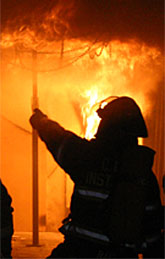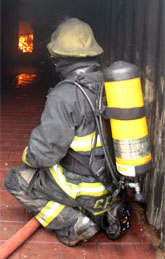CFBT Level I Information Sheet


|
|
Download the CFBT Level I information sheet in PDF format. |
Course Description
Compartment Fire Behavior Training (CFBT) Level I examines fire behavior in a structural environment. Critical learning outcomes include the ability to recognize fire behavior indicators, predict fire development, and implement appropriate control measures to improve firefighter safety and fire control effectiveness.
The CFBT Level I course provides participants with a fundamental understanding of fire behavior, fire development in a compartment, and develops foundational fire control skills.
Target Audience
CFBT Level I is intended for firefighters and fire officers. While this is an introductory level CFBT program, the case studies and hands-on exercises provide an excellent learning opportunity for both novices and experienced members.
Prerequisites
Participants must have completed the training required to participate in live fire training as outlined in National Fire Protection Association 1403 Standard on Live Fire Training (or the requirements of applicable state law, whichever is more stringent). Specifically students shall have received training to meet the job performance requirements for Fire Fighter I in NFPA 1001, Standard for Fire Fighter Professional Qualifications, related to the following subjects:
|
|
Participants must be medically and physically qualified to wear self-contained breathing apparatus (SCBA). Occupational Safety and Health Administration (OSHA) Respiratory Protection regulations (29 Code of Federal Regulations (CFR) 1910. 134) require that individuals who wear self-contained breathing apparatus (SCBA) receive an annual medical evaluation and be fit tested for the breathing apparatus used. In addition, this regulation prohibits conditions that may interfere with facepiece seal (e.g., facial hair in the area of the facepiece seal).
NFPA 1981 Standard on Open-Circuit SCBA for Emergency Services (2007) and NFPA 1500 Standard on Fire Department Occupational Safety and Health Program (2007) provide additional information on the medical and physical qualification for the use of SCBA.
Class Size
The interactive nature of classroom presentation and hands-on, live fire elements of this course generally limit class size to a maximum of 12 participants. Larger classes may be accommodated, but this requires use of additional instructors and logistical support to ensure participant safety and an effective learning environment.
Credit & Certification
This course is not designed to meet specific certification requirements (however the content of this course meets in part the requirements of NFPA Standard 1001 Firefighter Professional Qualifications (5.3.10, 5.3.11, 5.3.12, and 6.3.2).
Schedule
This 16-hour course is generally delivered over two consecutive days and integrates classroom instruction, case studies, small-scale lab demonstrations, and several live fire training sessions to provide an overview of compartment fire behavior, dynamic risk assessment and 3D firefighting concepts.
| Day 1 | Day 2 |
|---|---|
|
|
Learning Outcomes
Critical learning outcomes include the ability to recognize fire behavior indicators, predict fire development, and implement appropriate control measures to improve firefighter safety and fire control effectiveness. Specific learning outcomes are as follows:
Introduction (Classroom)
- Recognize the need for an in-depth theoretical and practical knowledge of fire behavior.
- Understand the underlying concept of compartment fire behavior training (CFBT.
Health and Safety (Classroom)
- Recognize the physiological stress that results from working in protective clothing and SCBA in a high temperature environment.
- Understand the rationale for medical monitoring during physiologically stressful training operations.
Fundamentals of Fire Behavior (Classroom)
- Describe the basic chemical and physical processes involved in combustion.Explain fire phenomena using the fire triangle and tetrahedron as simple models of combustion.
- Explain basic concepts of thermal dynamics, including: thermal energy, temperature, and methods of heat transfer.
- Describe the combustion process for gaseous, liquid, and solid fuels.
- Explain the concepts of heat of combustion and heat release rate.
- Describe the influence of the fuel/oxygen mixture on combustion.
- Explain the concept of chemical chain reaction as it relates to flaming combustion.
- Recognize characteristics of common types of combustion products.
- Be able to use terminology related to combustion and fire dynamics.
Fire Development in a Compartment (Classroom)
- Describe the general development of a fire and extension beyond a single room or compartment, including: Heat transfer methods, pressurization within the space, stages of fire development and transition from fuel controlled to ventilation controlled combustion.
- Identify building factors influencing fire development.
- Explain the concepts of fire load and ventilation profile.
- Explain the significance of the transition from a contents fire to a structural fire.
- Be able to use terminology related to fire development, including: plume, ceiling jet, hot gas layer, neutral plane, air track and gravity current.
- Explain the impact of the following factors on fire development in a compartment: Type of fuel, availability and locations of additional fuel, volume of the compartment, ceiling height, size, number, and arrangement of ventilation openings, and thermal properties of the enclosure (insulation).
Case Studies (Classroom/Out of Class Activity)
- Recognize how case studies can contribute to your knowledge of fire behavior.
- Use fire behavior theory to analyze incidents involving extreme fire behavior.
Fire Behavior Demonstration 1 (Live Fire)
- Describe anticipated fire behavior based on conditions experienced inside a compartment under actual fire conditions.
- Using visual observation under actual fire conditions, identify the following: Evidence of pyrolysis, neutral plane, air track, and rollover.
Extreme Fire Behavior (Classroom)
- Recognize the hazards presented by extreme fire behavior.
- Explain how the following three extreme fire behavior phenomena occur: Flashover, backdraft, smoke explosion.
- Explain the influence of changes in ventilation profile in each of the following burning regimes: Fuel controlled and ventilation controlled.
- Differentiate between the following: Ventilation, unplanned ventilation, tactical ventilation, and tactical anti-ventilation.
- Recognize the significance of fire behavior indicators in each of the following categories: Building, smoke, air track, heat, and flame.
Burning Down the (Dolls) House (Laboratory Exercise)
- Build and understanding of the process of fire development in a compartment and extreme fire behavior phenomena of flashover and backdraft using a small-scale demonstration.
Case Study Presentations (Classroom)
- Analyze case studies involving extreme fire behavior to identify: The type of extreme fire behavior phenomena involved, causal factors that contributed to the occurrence of extreme fire behavior, and mitigation strategies that could have changed the outcome of the incident.
Nozzle Techniques and Door Entry (Classroom and Hands-On)
- Identify and describe factors influencing the effectiveness of extinguishment by cooling.
- Describe the application of indirect attack, direct attack, and 3D gas cooling.
- Demonstrate the nozzle techniques for pulsing, penciling, and painting.
- Recognize key door entry size-up and dynamic risk assessment factors.
- Understand how integrated door control and gas cooling reduce the risk of extreme fire behavior during door entry.
- Demonstrate effective door entry procedures.
Fire Behavior Demonstration 2 (Live Fire)
- Describe anticipated fire behavior based on conditions experienced inside a compartment under actual fire conditions.
- Demonstrate the following nozzle techniques under actual fire conditions: Pulsing (short pulse), penciling, and painting.
Student Manual
CFBT-US provides clients with the Level I Student Manual in electronic (PDF) format for local duplication. This manual contains all of the required readings for the course as well as materials for in-class learning activities.
Learning Activities & Assignments
Learning activities include class discussion, oral presentation of individual and team findings related to three case studies, and participation in the hands-on elements of the course.
Facilities & Logistics
There are a number of facility and logistical requirements necessary for effective delivery of CFBT Level I. These include:
Classroom
Required classroom facilities include a white board, projection screen, data projector, and seating at tables for the number of learners who will be participating in the class.
Live Fire Facilities
Generally CFBT Level I is conducted using a single level or split level, container-based fire training prop. However, course delivery may be adapted to burn buildings designed for Class A or Class B (gas) fuel. Contact CFBT-US for additional information on facilities requirements.
Logistical Support
Logistical requirements include the following:
- Duplication of Student Manuals (PDF file provided)
- SCBA for each participant (including CFBT-US Instructors)
- Students must have personal protective euqipment as outlined in NFPA 1403.
- Cascade system or breathing air compressor for cylinder refill
- Drinking water for participant rehab
- Two fire apparatus capable of supplying multiple hoselines flowing 125 gpm
- Water supply to support hands-on training (continuous supply or 3000 gallons on-site)
- Dolls houses for fire development lab exercise (this simple prop is constructed from ¾” (16 mm) particle board (plans provided)
- Access to Emergency Medical Services (EMS)
- Fuel for live fire evolutions (approximately 16 sheets of ½” (12 mm) particleboard depending on the specific prop or live fire training facilities used).
During the initial live fire training evolution, the fuel requirements for this specific prop will be evaluated and adjusted. CFBT-US policy is to use the minimum amount of fuel that will meet specified training objectives (this minimizes risk to participants and waste of fuel materials). Fuel used during CFBT must meet the requirements outlined in NFPA 1403. Standard ½” (12 mm) particle board serves as a safe and effective fuel for compartment fire behavior training evolutions. This fuel provides predictable fire development and sufficient burn duration to conduct instructional activities. The evolutions conducted during this course typically require no more than 8 sheets of ½” (12 mm) particle board depending on container configuration. Use of varied types of fuel such as plywood, oriented strand board (OSB) results in a much higher heat release rate and shorter duration of burn. Pallets are an extremely variable fuel (type of wood, configuration, etc.). While these types of fuel are acceptable for some types of training activities, they are not generally used during basic CFBT.
Instructors
A minimum of two CFBT instructors are required for delivery of CFBT Level I (additional instructors may be needed depending on class size).
All CFBT-US instructors are experienced firefighters and fire officers who have completed CFBT Instructor program and have substantive experience in applying the knowledge and skills presented in this training program in an operational firefighting environment and in delivery of CFBT to diverse fire service audiences. See About CFBT for more information about our instructors.
Training Philosophy
CFBT-US believes that learning is more than simply being present and receiving information. Participants are expected to actively engage in class activities and develop an expanded and deeper understanding of course concepts and basic proficiency in hands-on skills. Classes provide both classroom based and hands-on demonstrations and application activities to provide learners with a variety of ways to develop skill and understanding.
Course Policies
Learners must meet all prerequisites in order to participate in the live fire training segments of this course. Individuals who do not meet these requirements may participate in classroom sessions and laboratory exercises, but will be given a certificate of attendance rather than a certificate of completion.
Members are encouraged to share their experience and be active participants during class sessions. It is likely that information will be presented (either by the instructors or fellow learners) that will challenge participants current views about fire behavior or firefighting methods. Please keep an open mind and evaluate the ideas presented on the basis of both scientific principles and your experience as a firefighter.
The CFBT Level I course includes one out of class assignment. This assignment involves reading three short case studies and preparing answers to a series of questions for each case study. Completion of this assignment is not optional in that discussion of the case studies is an integral part of class activity.
Additional Information
For additional information on the CFBT Level I course or to request a quotation or proposal, Contact CFBT-US.

